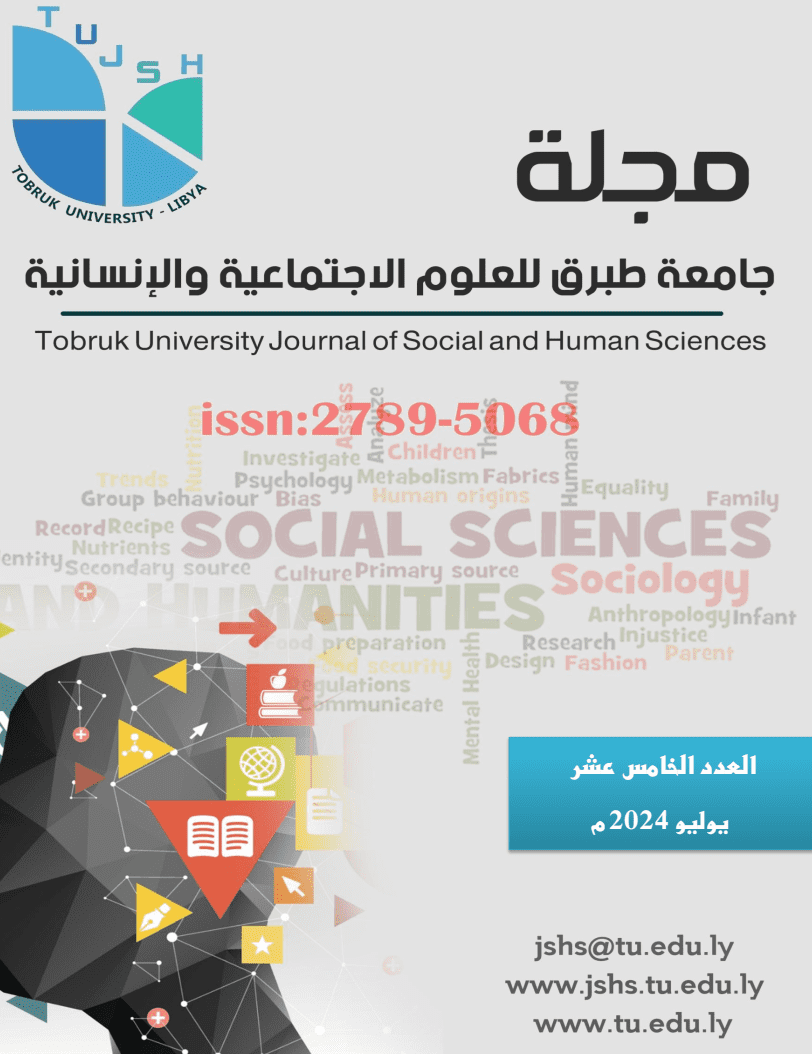The Oasis of Ghibub in Ancient Times
DOI:
https://doi.org/10.64516/xrpc5932Keywords:
SiwaAbstract
The ease of communication between Libya and Egypt, and the lack of natural barriers separating them, gave geographical importance to the Siwa Oasis as a station connecting the Libyan desert and the Nile Valley through the Siwa Oasis. This location had an effective impact on the transfer of civilizational manifestations since the earliest times. The Libyan human being turned to the Nile Valley rather than others through these oases when the climate changed and the Dry Age began; the Siwa Oasis in those eras was an environment with a great impact on communications and the exchange of religious and civilizational beliefs. The civilization that was transferred from the Libyan desert through these oases was an intellectual civilization, experiences and experiments; which contributed to enhancing cultural interaction with its geographical environment, pushing the Libyan human being, carrying his beliefs, ideas and experiences, to start his life on the banks of the Nile Valley with the cultures of the desert.during the historical era, the ancient Libyan human was able to overcome geographical and social distances through commercial contact with Egypt through the Siwa Oasis, especially in the Pharaonic era, where the historian Herodotus mentioned desert routes for caravans through the oases, extending from the Nile Valley to the west, linking the Egyptian and Libyan oases and starting from Thebes in southern Egypt to the Libyan interior where the Augila Oasis appears as a pivot of a network of desert caravan routes. This, in my opinion, helped the desert human being to reuse the ancient commercial caravan routes starting from the Fezzan Oases to the Siwa Oasis, passing through the Siwa Oasis, where many Pharaonic tombs and mummies were found, considering it a settlement site of importance on the trade routes with Siwa and then Thebes. Therefore, the Siwa Oasis is a blend of objective and subjective elements in an integrated historical, social and doctrinal reality with the Egyptian Oases, within the framework of an accumulated historical territorial unity with the Libyan Oases throughout the ancient historical eras.hence, the interest in studying and addressing the history of the Siwa Oasis in ancient times has been activated, as one of the most important forms of civilizational interaction and its impact on neighboring cultures and civilizations
Downloads
References
1. غوتي منال، سيلة سلاف، العصر الحجري الحديث في الجزائر، رسالة ماجستير غير منشورة ، كلية العلوم الإنسانية والاجتماعية قسم التاريخ، جامعة 8 ماي 1945،الجزائر، 2015-2016، ص أ.
2. عبدالعزيز طريح شرف، جغرافية ليبيا، مركز الاسكندرية للكتاب، الإسكندرية، ط 3، 1996، ص 69
3. عبدالعزيز طريح شرف، جغرافية ليبيا، مرجع سابق، ص ص 69-70.
4. محمد أبو المحاسن عصفور، معالم حضارات الشرق الأدنى القديم، المرجع السابق، ص 291.
5. بن السعدي سليمان، علاقات مصر بالمغرب القديم منذ فجر التاريخ حتى القرن 7 ق.م، اطروحة دكتوراه غيرمنشورة، جامعة منتوري قسنطينة، الجزائر، 2008-2009، ص ص 129-130.
6. لاروند، أندريه، في تاريخ ليبيا القديم (برقة في العصر الهيلينستي) من العهد الجمهوري حتى ولاية أغسطس، ترجمة محمد عبد الكريم الوافي، منشورات جامعة قار يونس، ط1، بنغازي. 2002،ص215.
7. سالم محمد عبدالله هويدي، الحضارة الجرمية-دراسة في عوامل النشؤ والازدهار والانهيار، منشورات المركز الوطني للمحفوظات والدراسات التاريخية، طرابلس، 2010،ص ص119،224،225.
8. لاروند، أندريه، في تاريخ ليبيا القديم (برقة في العصر الهيلينستي) من العهد الجمهوري حتى ولاية أغسطس، المرجع السابق، ص239.
9. محمد سليمان أيوب، جرمة من تاريخ الحضارة الليبية، دار المصراتي للطباعة والنشر، طرابلس،1969، ص 199.
10. رجب عبدالحميد الأثرم، هيرودوتس والليبيون، مجلة البحوث التاريخية، طرابلس، منشورات مركز جهاد الليبيين للدراسات التاريخية ،ع 2، السنة الرابعة عشرة، 1993، ص 33-72.
11. سالم محمد عبدالله هويدي، الحضارة الجرمية-دراسة في عوامل النشؤ والازدهار والانهيار، المرجع السابق، ص119
12. سالم محمد عبدالله هويدي، الحضارة الجرمية- المرجع السابق، ص119
13. Bovill, E.W., The Golden Trade of The Moors, London1968, PP. 18-22
14. فرنسوا شامو، في تاريخ ليبيا القديم- الإغريق في برقة-الأسطورة والتاريخ، ت.محمد عبدالكريم الوافي ، بنغازي ، منشورات جامعة قار يونس، ط1، 1990، ص ص 42-46.
15. محمد مصطفى بازامة، تأثير الليبيين في الحضارتين المصرية واليونانية وتأثرهم بهما، ليبيا في التاريخ، المؤتمر التاريخي الذي نظمته الجامعة الليبية في الفترة من 16 الى 23 مارس 1968، منشورات الجامعة الليبية، بنغازي، 1968، ص 88.
i. Wainwright,G.A.,The SkyReligion in Egypt Cambridge,1938,p85
16. عبداللطيف محمود البرغوثي، التاريخ الليبي القديم من أقدم العصور حتى الفتح الإسلامي، ج1، منشورات تامغناست ،د.ت، ص 186
17. عبدالكريم فضيل الميار، قورينا وبرقة في العصر الروماني من 74 ق.م- 117 م، طرابلس، منشورات الشركة العامة للنشر والتوزيع والإعلان، ط1،1978، 13.
18. رجب عبدالحميد الأثرم، محاضرات في تاريخ ليبيا القديم ،منشورات جامعة قاريونس، بنغازي، ط 2-3، 1998، ص119.
19. عبداللطيف محمود البرغوثي، التاريخ الليبي القديم من أقدم العصور حتى الفتح الإسلامي، ج1، بيروت ، دار صادر، ص 186
20. فيليب كنريك، قورينائية(إقليم المدن الخمس)،ت. أحمد بوزيان وعبدالله الرحيبي، مطبوعات جمعية الدراسات الليبية، تونس، 2013، ص329
21. فيليب كنريك، قورينائية(إقليم المدن الخمس)،المرجع السابق، ص 329
22. مقابلة شخصية أجراها الباحث الدكتور أحميده خيرالله الداره مع الراوي وهو المواطن الليبي السيد (الجبالي تركي مجيد سعد، قطعاني عيت يونس) من سكان مدينة طبرق ، حي الحرية، بتاريخ 10/8/2023م
23. ر.ج. جودتشايلد، دراسات ليبية، ت. عبدالحفيظ فضيل الميار، أحمد اليازوري، مركز جهاد الليبيين للدراسات التاريخية، طرابلس، 1999، ص ص 496-497.
24. فيليب كنريك، قورينائية(إقليم المدن الخمس)،ت. أحمد بوزيان وعبدالله الرحيبي، مطبوعات جمعية الدراسات الليبية، تونس، 2013، ص329.
Downloads
Published
Issue
Section
License
Copyright (c) 2024 الدكتور.أحميدة خيرالله الداره مسعود (Autor/in)

This work is licensed under a Creative Commons Attribution 4.0 International License.








